Promoting Positive Behavior Through Interventions
VerifiedAdded on 2020/06/04
|8
|1691
|72
AI Summary
This assignment delves into the influence of social determinants on mental well-being. It emphasizes the importance of least intervention approaches to empower individuals and foster self-control. The paper examines proactive and reactive strategies for encouraging positive behaviors, highlighting restorative practices within educational settings. Additionally, it discusses the role of peer-to-peer support and social media in shaping mental health care.
Contribute Materials
Your contribution can guide someone’s learning journey. Share your
documents today.
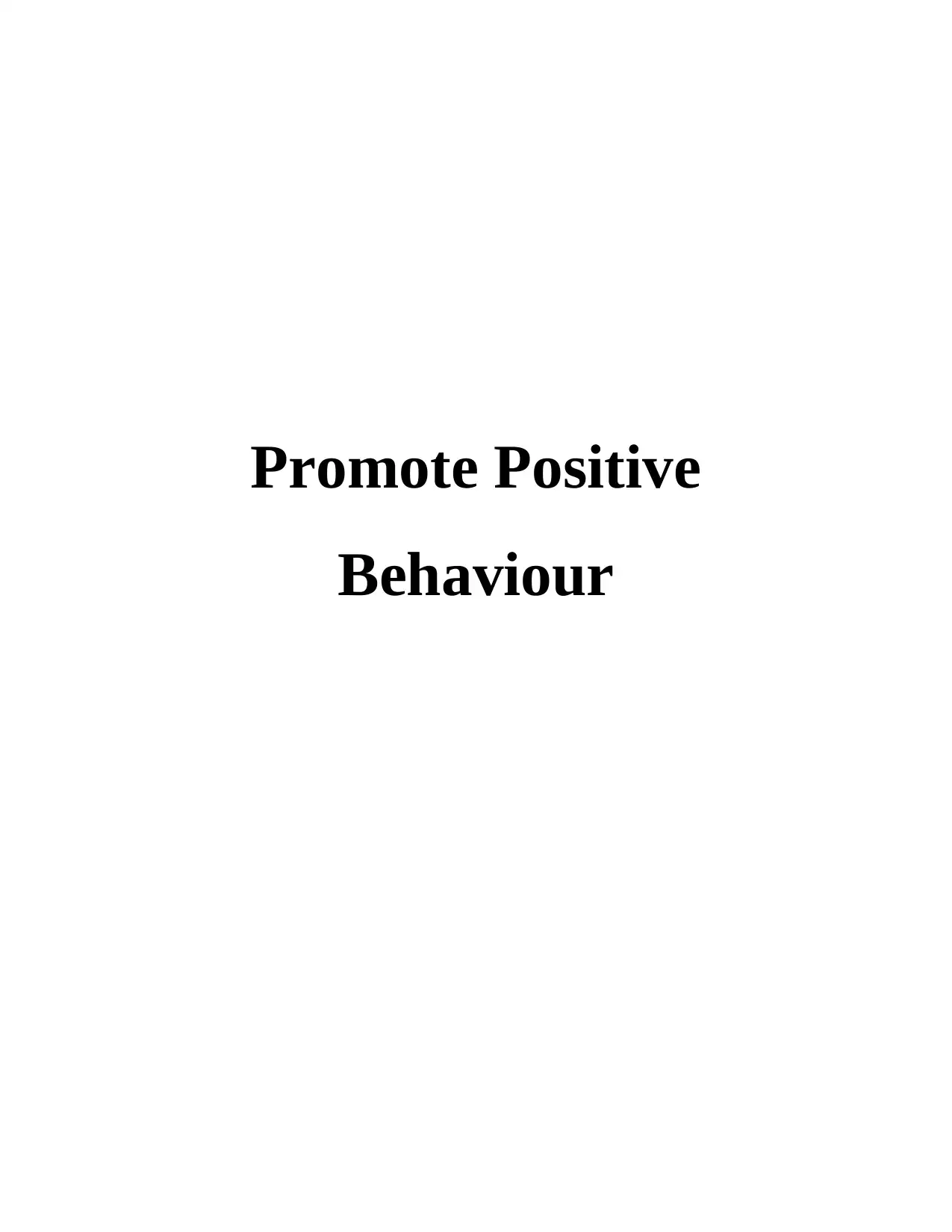
Promote Positive
Behaviour
Behaviour
Secure Best Marks with AI Grader
Need help grading? Try our AI Grader for instant feedback on your assignments.
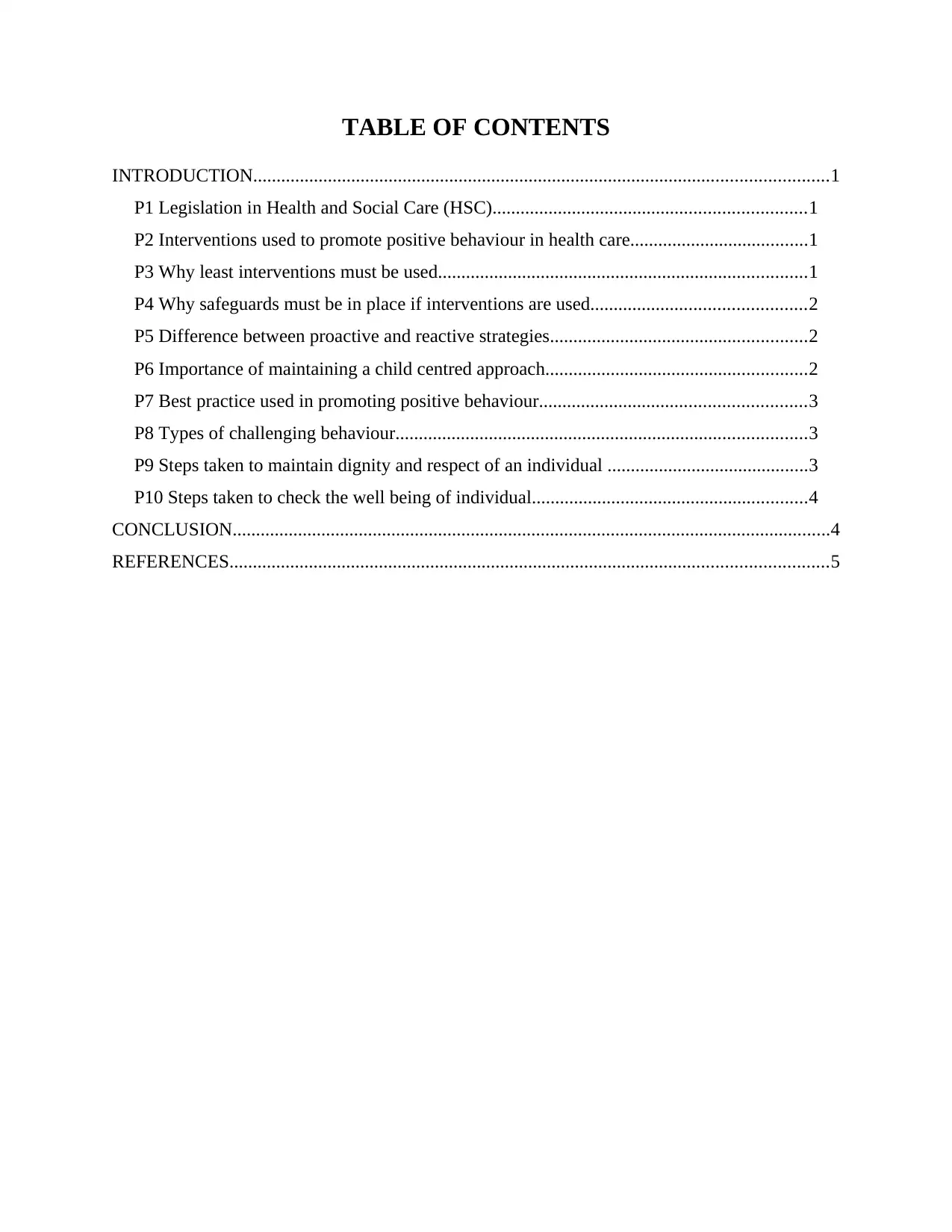
TABLE OF CONTENTS
INTRODUCTION...........................................................................................................................1
P1 Legislation in Health and Social Care (HSC)...................................................................1
P2 Interventions used to promote positive behaviour in health care......................................1
P3 Why least interventions must be used...............................................................................1
P4 Why safeguards must be in place if interventions are used..............................................2
P5 Difference between proactive and reactive strategies.......................................................2
P6 Importance of maintaining a child centred approach........................................................2
P7 Best practice used in promoting positive behaviour.........................................................3
P8 Types of challenging behaviour........................................................................................3
P9 Steps taken to maintain dignity and respect of an individual ...........................................3
P10 Steps taken to check the well being of individual...........................................................4
CONCLUSION................................................................................................................................4
REFERENCES................................................................................................................................5
INTRODUCTION...........................................................................................................................1
P1 Legislation in Health and Social Care (HSC)...................................................................1
P2 Interventions used to promote positive behaviour in health care......................................1
P3 Why least interventions must be used...............................................................................1
P4 Why safeguards must be in place if interventions are used..............................................2
P5 Difference between proactive and reactive strategies.......................................................2
P6 Importance of maintaining a child centred approach........................................................2
P7 Best practice used in promoting positive behaviour.........................................................3
P8 Types of challenging behaviour........................................................................................3
P9 Steps taken to maintain dignity and respect of an individual ...........................................3
P10 Steps taken to check the well being of individual...........................................................4
CONCLUSION................................................................................................................................4
REFERENCES................................................................................................................................5
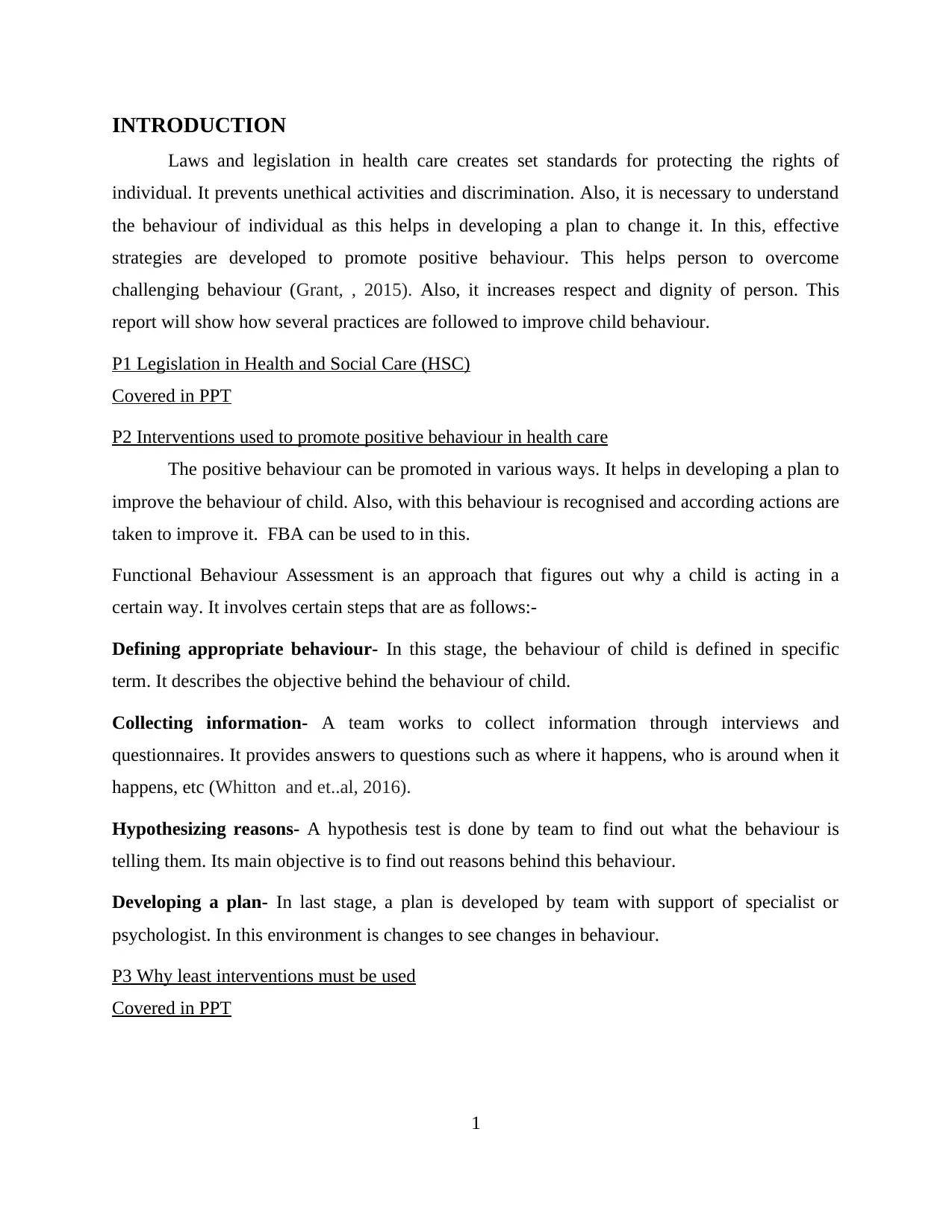
INTRODUCTION
Laws and legislation in health care creates set standards for protecting the rights of
individual. It prevents unethical activities and discrimination. Also, it is necessary to understand
the behaviour of individual as this helps in developing a plan to change it. In this, effective
strategies are developed to promote positive behaviour. This helps person to overcome
challenging behaviour (Grant, , 2015). Also, it increases respect and dignity of person. This
report will show how several practices are followed to improve child behaviour.
P1 Legislation in Health and Social Care (HSC)
Covered in PPT
P2 Interventions used to promote positive behaviour in health care
The positive behaviour can be promoted in various ways. It helps in developing a plan to
improve the behaviour of child. Also, with this behaviour is recognised and according actions are
taken to improve it. FBA can be used to in this.
Functional Behaviour Assessment is an approach that figures out why a child is acting in a
certain way. It involves certain steps that are as follows:-
Defining appropriate behaviour- In this stage, the behaviour of child is defined in specific
term. It describes the objective behind the behaviour of child.
Collecting information- A team works to collect information through interviews and
questionnaires. It provides answers to questions such as where it happens, who is around when it
happens, etc (Whitton and et..al, 2016).
Hypothesizing reasons- A hypothesis test is done by team to find out what the behaviour is
telling them. Its main objective is to find out reasons behind this behaviour.
Developing a plan- In last stage, a plan is developed by team with support of specialist or
psychologist. In this environment is changes to see changes in behaviour.
P3 Why least interventions must be used
Covered in PPT
1
Laws and legislation in health care creates set standards for protecting the rights of
individual. It prevents unethical activities and discrimination. Also, it is necessary to understand
the behaviour of individual as this helps in developing a plan to change it. In this, effective
strategies are developed to promote positive behaviour. This helps person to overcome
challenging behaviour (Grant, , 2015). Also, it increases respect and dignity of person. This
report will show how several practices are followed to improve child behaviour.
P1 Legislation in Health and Social Care (HSC)
Covered in PPT
P2 Interventions used to promote positive behaviour in health care
The positive behaviour can be promoted in various ways. It helps in developing a plan to
improve the behaviour of child. Also, with this behaviour is recognised and according actions are
taken to improve it. FBA can be used to in this.
Functional Behaviour Assessment is an approach that figures out why a child is acting in a
certain way. It involves certain steps that are as follows:-
Defining appropriate behaviour- In this stage, the behaviour of child is defined in specific
term. It describes the objective behind the behaviour of child.
Collecting information- A team works to collect information through interviews and
questionnaires. It provides answers to questions such as where it happens, who is around when it
happens, etc (Whitton and et..al, 2016).
Hypothesizing reasons- A hypothesis test is done by team to find out what the behaviour is
telling them. Its main objective is to find out reasons behind this behaviour.
Developing a plan- In last stage, a plan is developed by team with support of specialist or
psychologist. In this environment is changes to see changes in behaviour.
P3 Why least interventions must be used
Covered in PPT
1

P4 Why safeguards must be in place if interventions are used
Covered in PPT
P5 Difference between proactive and reactive strategies
In order to promote positive behaviour certain strategies are followed. These strategies
help in changing environment through which the behaviour of individual can be changed. For
this, proactive and reactive strategies are used:-
Proactive strategies- They are already in place for changing behaviour. It includes effective
communication, rule-making and boundary setting, etc (Holt,, 2016). It focuses on knowing what
is expected from a child. Praising is the best way to promote positive behaviour.
Reactive strategies- It deals with the inappropriate behaviour of individual. The goal is to help
child to control risky behaviour. If child behaves inappropriate, then it must be directed towards
proper behaviour.
P6 Importance of maintaining a child centred approach
For maintaining child centred approach, various action plans are developed. These
includes:-
Making Action plans (MAPS) - It is a process in which student future plan is made. It is made
by considering the interest and needs of them. In this, both the student and family member
participate in making the future plan.
Planning Alternative Tomorrows with Hope (PATH) - A planning tool that starts by imaging
and detailing the future of a person (Naidoo,. and Wills,, 2016). It is done by team that focuses
on first step to be considered in achieving future of children. This is a result based process.
Personal Future Planning (PFP) - In this, the focus is shifted from system centred method to
person centred method. It helps in encouraging child to contribute more towards the society.
With this, the child becomes aware about his potential.
P7 Best practice used in promoting positive behaviour
A positive behaviour will make the child stress
free. This will enable child to think positive in
every situation. Moreover, it will encourage
him to help others and create positive
Promoting the benefits- By communicating
the benefits of positive behaviour, individual
will know about the importance of his
behaviour with other people. Also, it will be
2
Covered in PPT
P5 Difference between proactive and reactive strategies
In order to promote positive behaviour certain strategies are followed. These strategies
help in changing environment through which the behaviour of individual can be changed. For
this, proactive and reactive strategies are used:-
Proactive strategies- They are already in place for changing behaviour. It includes effective
communication, rule-making and boundary setting, etc (Holt,, 2016). It focuses on knowing what
is expected from a child. Praising is the best way to promote positive behaviour.
Reactive strategies- It deals with the inappropriate behaviour of individual. The goal is to help
child to control risky behaviour. If child behaves inappropriate, then it must be directed towards
proper behaviour.
P6 Importance of maintaining a child centred approach
For maintaining child centred approach, various action plans are developed. These
includes:-
Making Action plans (MAPS) - It is a process in which student future plan is made. It is made
by considering the interest and needs of them. In this, both the student and family member
participate in making the future plan.
Planning Alternative Tomorrows with Hope (PATH) - A planning tool that starts by imaging
and detailing the future of a person (Naidoo,. and Wills,, 2016). It is done by team that focuses
on first step to be considered in achieving future of children. This is a result based process.
Personal Future Planning (PFP) - In this, the focus is shifted from system centred method to
person centred method. It helps in encouraging child to contribute more towards the society.
With this, the child becomes aware about his potential.
P7 Best practice used in promoting positive behaviour
A positive behaviour will make the child stress
free. This will enable child to think positive in
every situation. Moreover, it will encourage
him to help others and create positive
Promoting the benefits- By communicating
the benefits of positive behaviour, individual
will know about the importance of his
behaviour with other people. Also, it will be
2
Secure Best Marks with AI Grader
Need help grading? Try our AI Grader for instant feedback on your assignments.
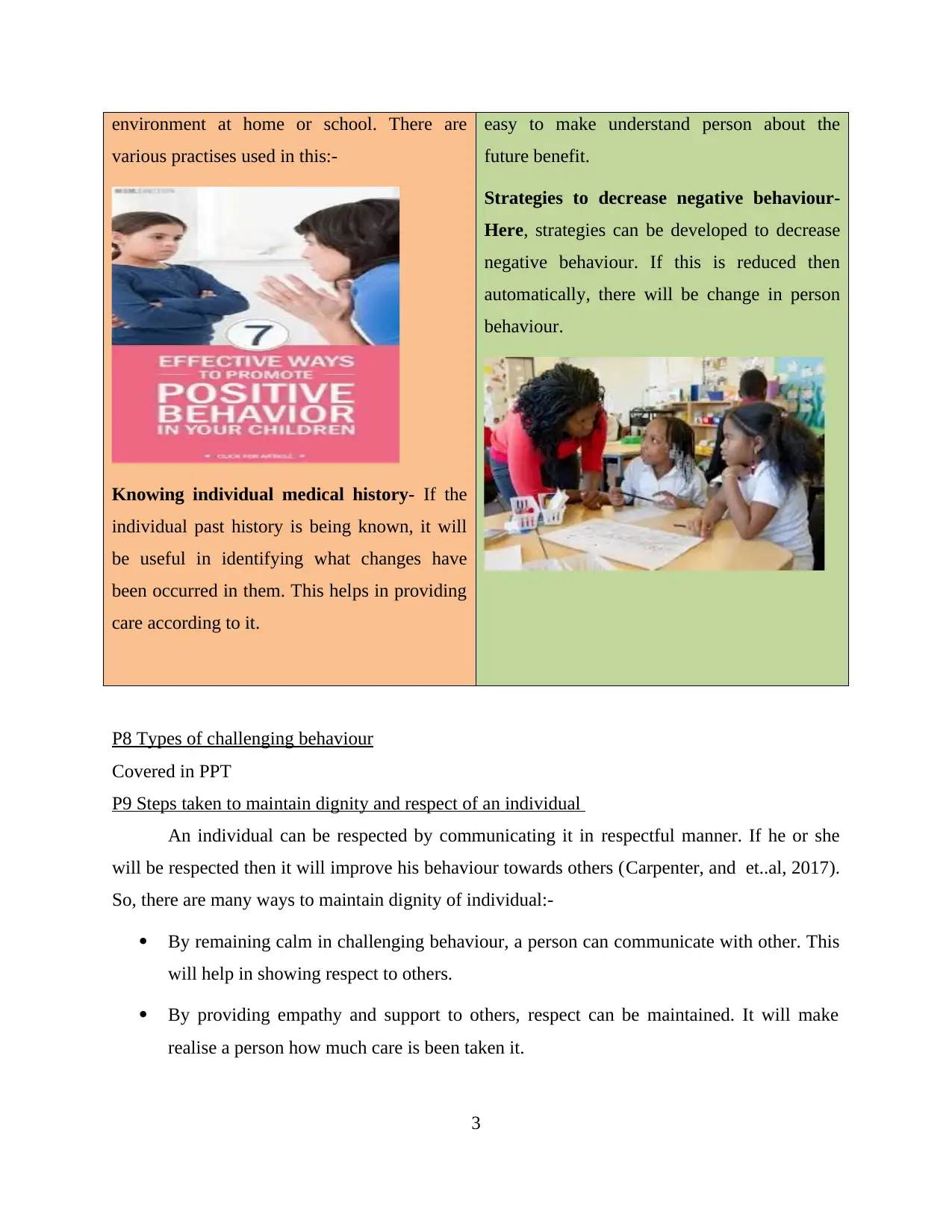
environment at home or school. There are
various practises used in this:-
Knowing individual medical history- If the
individual past history is being known, it will
be useful in identifying what changes have
been occurred in them. This helps in providing
care according to it.
easy to make understand person about the
future benefit.
Strategies to decrease negative behaviour-
Here, strategies can be developed to decrease
negative behaviour. If this is reduced then
automatically, there will be change in person
behaviour.
P8 Types of challenging behaviour
Covered in PPT
P9 Steps taken to maintain dignity and respect of an individual
An individual can be respected by communicating it in respectful manner. If he or she
will be respected then it will improve his behaviour towards others (Carpenter, and et..al, 2017).
So, there are many ways to maintain dignity of individual:-
By remaining calm in challenging behaviour, a person can communicate with other. This
will help in showing respect to others.
By providing empathy and support to others, respect can be maintained. It will make
realise a person how much care is been taken it.
3
various practises used in this:-
Knowing individual medical history- If the
individual past history is being known, it will
be useful in identifying what changes have
been occurred in them. This helps in providing
care according to it.
easy to make understand person about the
future benefit.
Strategies to decrease negative behaviour-
Here, strategies can be developed to decrease
negative behaviour. If this is reduced then
automatically, there will be change in person
behaviour.
P8 Types of challenging behaviour
Covered in PPT
P9 Steps taken to maintain dignity and respect of an individual
An individual can be respected by communicating it in respectful manner. If he or she
will be respected then it will improve his behaviour towards others (Carpenter, and et..al, 2017).
So, there are many ways to maintain dignity of individual:-
By remaining calm in challenging behaviour, a person can communicate with other. This
will help in showing respect to others.
By providing empathy and support to others, respect can be maintained. It will make
realise a person how much care is been taken it.
3

In a situation where the body parts of person is been exposed then individual can cover it
with his clothes (Sirois, , Kitner. and Hirsch,, 2015). This will be helpful in providing
respect to the person.
P10 Steps taken to check the well being of individual
Life space interview- It is an approach that is used to manager the behaviour. In this the
behaviour is analysed at the time of occurring of event.
IESCAPE acronym- Its abbreviation is given below:-
I- Isolating conversation with person
E- Exploring person point of view
S- Summarising person past events and incidents
C- Connecting person feeling with his behaviour
A- Alternative behaviour must be suggested to person
P- Planning different behaviour to deal with similar situation
E- Enter the person back into routine
CONCLUSION
From this report, it is concluded that HSC must be managed and controlled by various
laws and legislation. These laws ensure that services in health care are given according to
standards mentioned in legislation. Besides this, positive behaviour can be promoted in various
ways. It helps in developing a plan to improve the behaviour of child. Along with this, behaviour
is recognised and accordingly actions are taken to improve it. Moreover, least interventions help
in restoring the individual self-control in quick time period. Proactive and reactive strategies are
followed to promote positive behaviour.
4
with his clothes (Sirois, , Kitner. and Hirsch,, 2015). This will be helpful in providing
respect to the person.
P10 Steps taken to check the well being of individual
Life space interview- It is an approach that is used to manager the behaviour. In this the
behaviour is analysed at the time of occurring of event.
IESCAPE acronym- Its abbreviation is given below:-
I- Isolating conversation with person
E- Exploring person point of view
S- Summarising person past events and incidents
C- Connecting person feeling with his behaviour
A- Alternative behaviour must be suggested to person
P- Planning different behaviour to deal with similar situation
E- Enter the person back into routine
CONCLUSION
From this report, it is concluded that HSC must be managed and controlled by various
laws and legislation. These laws ensure that services in health care are given according to
standards mentioned in legislation. Besides this, positive behaviour can be promoted in various
ways. It helps in developing a plan to improve the behaviour of child. Along with this, behaviour
is recognised and accordingly actions are taken to improve it. Moreover, least interventions help
in restoring the individual self-control in quick time period. Proactive and reactive strategies are
followed to promote positive behaviour.
4
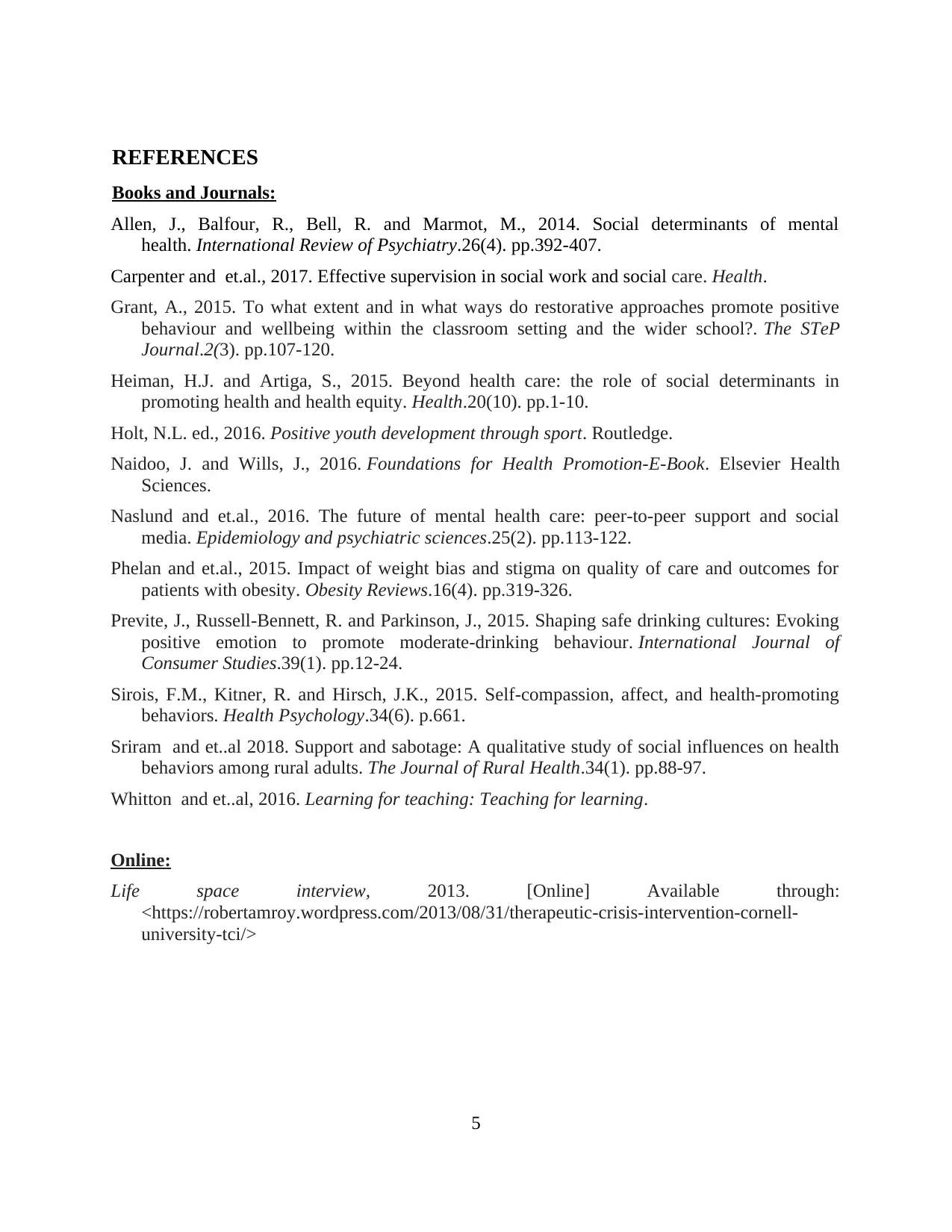
REFERENCES
Books and Journals:
Allen, J., Balfour, R., Bell, R. and Marmot, M., 2014. Social determinants of mental
health. International Review of Psychiatry.26(4). pp.392-407.
Carpenter and et.al., 2017. Effective supervision in social work and social care. Health.
Grant, A., 2015. To what extent and in what ways do restorative approaches promote positive
behaviour and wellbeing within the classroom setting and the wider school?. The STeP
Journal.2(3). pp.107-120.
Heiman, H.J. and Artiga, S., 2015. Beyond health care: the role of social determinants in
promoting health and health equity. Health.20(10). pp.1-10.
Holt, N.L. ed., 2016. Positive youth development through sport. Routledge.
Naidoo, J. and Wills, J., 2016. Foundations for Health Promotion-E-Book. Elsevier Health
Sciences.
Naslund and et.al., 2016. The future of mental health care: peer-to-peer support and social
media. Epidemiology and psychiatric sciences.25(2). pp.113-122.
Phelan and et.al., 2015. Impact of weight bias and stigma on quality of care and outcomes for
patients with obesity. Obesity Reviews.16(4). pp.319-326.
Previte, J., Russell‐Bennett, R. and Parkinson, J., 2015. Shaping safe drinking cultures: Evoking
positive emotion to promote moderate‐drinking behaviour. International Journal of
Consumer Studies.39(1). pp.12-24.
Sirois, F.M., Kitner, R. and Hirsch, J.K., 2015. Self-compassion, affect, and health-promoting
behaviors. Health Psychology.34(6). p.661.
Sriram and et..al 2018. Support and sabotage: A qualitative study of social influences on health
behaviors among rural adults. The Journal of Rural Health.34(1). pp.88-97.
Whitton and et..al, 2016. Learning for teaching: Teaching for learning.
Online:
Life space interview, 2013. [Online] Available through:
<https://robertamroy.wordpress.com/2013/08/31/therapeutic-crisis-intervention-cornell-
university-tci/>
5
Books and Journals:
Allen, J., Balfour, R., Bell, R. and Marmot, M., 2014. Social determinants of mental
health. International Review of Psychiatry.26(4). pp.392-407.
Carpenter and et.al., 2017. Effective supervision in social work and social care. Health.
Grant, A., 2015. To what extent and in what ways do restorative approaches promote positive
behaviour and wellbeing within the classroom setting and the wider school?. The STeP
Journal.2(3). pp.107-120.
Heiman, H.J. and Artiga, S., 2015. Beyond health care: the role of social determinants in
promoting health and health equity. Health.20(10). pp.1-10.
Holt, N.L. ed., 2016. Positive youth development through sport. Routledge.
Naidoo, J. and Wills, J., 2016. Foundations for Health Promotion-E-Book. Elsevier Health
Sciences.
Naslund and et.al., 2016. The future of mental health care: peer-to-peer support and social
media. Epidemiology and psychiatric sciences.25(2). pp.113-122.
Phelan and et.al., 2015. Impact of weight bias and stigma on quality of care and outcomes for
patients with obesity. Obesity Reviews.16(4). pp.319-326.
Previte, J., Russell‐Bennett, R. and Parkinson, J., 2015. Shaping safe drinking cultures: Evoking
positive emotion to promote moderate‐drinking behaviour. International Journal of
Consumer Studies.39(1). pp.12-24.
Sirois, F.M., Kitner, R. and Hirsch, J.K., 2015. Self-compassion, affect, and health-promoting
behaviors. Health Psychology.34(6). p.661.
Sriram and et..al 2018. Support and sabotage: A qualitative study of social influences on health
behaviors among rural adults. The Journal of Rural Health.34(1). pp.88-97.
Whitton and et..al, 2016. Learning for teaching: Teaching for learning.
Online:
Life space interview, 2013. [Online] Available through:
<https://robertamroy.wordpress.com/2013/08/31/therapeutic-crisis-intervention-cornell-
university-tci/>
5
Paraphrase This Document
Need a fresh take? Get an instant paraphrase of this document with our AI Paraphraser

6
1 out of 8
Related Documents
Your All-in-One AI-Powered Toolkit for Academic Success.
+13062052269
info@desklib.com
Available 24*7 on WhatsApp / Email
![[object Object]](/_next/static/media/star-bottom.7253800d.svg)
Unlock your academic potential
© 2024 | Zucol Services PVT LTD | All rights reserved.





